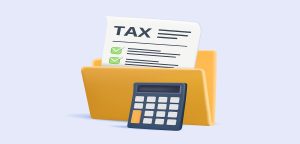Taxation is an essential aspect of a country’s financial ecosystem, and in India, the Income Tax Act governs the levy of taxes on individuals, corporations, and various entities. One of the critical sections that businesses and individuals need to be aware of is Section 140B of the Income Tax Act. This section deals with the reassessment and reopening of tax assessments and ensures that taxpayers meet their tax liabilities fairly and accurately.
In this blog, we’ll dive deep into how to calculate taxes under Section 140B of Income Tax Act and what it means for taxpayers. Additionally, we will explore how tools like online accounting software and cloud-based billing software can simplify tax calculation and filing, helping you stay compliant with the tax laws.
What is Section 140B of the Income Tax Act?
Before we get into the specifics of tax calculation under this section, it’s important to understand what Section 140B of Income Tax Act entails. This section primarily deals with the reopening of assessments for income tax. Specifically, Section 140B empowers the tax authorities to re-assess a tax return in the case of income under-reported or incorrectly reported, or if a taxpayer has failed to disclose certain income or facts in the initial filing.
The section essentially allows the Income Tax Department to reassess any assessment made under the Act if it feels there is a need for correction or investigation. This reassessment is based on new information or evidence that comes to light after the initial assessment.
Who Can be Affected by Section 140B?
Taxpayers may come under the purview of Section 140B under the following circumstances:
- Underreported Income: If there is evidence that income was underreported in the original assessment.
- Failure to Disclose: If certain income was not disclosed in the initial return and comes to light later.
- Assessment Errors: If there were mistakes in the original assessment, including clerical or computational errors.
How to Calculate Taxes Under Section 140B?
Calculating taxes under Section 140B is a process that essentially involves revisiting the initial tax return and correcting any discrepancies or inaccuracies found. Here’s a step-by-step approach to help you understand how taxes are calculated under this section:
Step 1: Identify the Need for Reassessment
The first step is to identify if there is any underreporting of income or any incorrect information in the tax return. This could be in the form of:
- Additional income discovered: If you had additional sources of income that were not disclosed in your original filing.
- Disallowed deductions: Certain deductions may have been claimed incorrectly or may not be applicable under the law.
The tax authorities may bring this to your attention during their scrutiny.
Step 2: Recalculate the Total Income
Once any discrepancies are identified, the next step is to recalculate your total income. This will include all sources of income that were initially left out or misreported. Common types of income that may need to be reconsidered are:
- Salary Income
- Business Income
- Capital Gains
- Rental Income
- Other Sources (Interest, Dividends, etc.)
Step 3: Calculate Taxable Income
After recalculating the total income, you must now determine your taxable income by subtracting eligible exemptions and deductions. This will include:
- Section 80C deductions (e.g., investments in PF, PPF, life insurance)
- Section 80D deductions (e.g., medical insurance premiums)
- Section 24(b) deductions (e.g., home loan interest)
Ensure that any previous mistakes are corrected during this step.
Step 4: Apply Tax Slabs
With your correct taxable income in hand, you will now apply the appropriate income tax slabs. As of the latest financial year, India follows progressive tax slabs, which means the more you earn, the higher the rate of tax you will pay. Below is a general outline of the tax slabs:
For Individual taxpayers below 60 years:
- Income up to ₹2.5 lakh – No Tax
- Income between ₹2.5 lakh and ₹5 lakh – 5%
- Income between ₹5 lakh and ₹10 lakh – 20%
- Income above ₹10 lakh – 30%
You may also be liable to pay Cess and Surcharge, depending on the total income.
Step 5: Reassess and File Revised Returns
Once you’ve applied the correct tax slabs, file a revised return with the updated information and corrections. This will ensure that your tax liability is in line with the actual income you earned.
Importance of Using Online Accounting and Cloud-Based Billing Software
Handling taxes can be overwhelming, but leveraging modern technology can make the entire process seamless. Using online accounting software and cloud based billing software like Margbooks can simplify the way you manage your taxes. Here’s how:
1. Automation of Tax Calculations
Online accounting software can automate the process of tax calculation by keeping track of your income and expenses in real time. This ensures that you have accurate data to base your tax filings on, reducing the risk of errors or omissions.
For example, Margbooks allows users to input their financial transactions and automatically generate tax reports. It ensures that every deduction, exemption, and income is properly calculated, minimizing the chances of tax underpayment or overpayment.
2. Cloud Storage for Easy Access
A major advantage of cloud-based billing software is that it provides secure cloud storage, which means you can access your financial data anytime, anywhere. This is particularly useful during the reassessment process under Section 140B. You can easily retrieve old invoices, receipts, and financial reports to cross-check information and make any necessary updates.
3. Easy Tax Filing Integration
Many cloud-based solutions, such as Margbooks, are integrated with government tax-filing portals. This makes it easier to file your taxes electronically, ensuring timely and accurate submission of your revised returns.
4. Real-Time Financial Monitoring
With real-time data and updates, online accounting software allows you to keep track of your financial performance and plan for future tax liabilities. This proactive approach ensures that you are always prepared for any reassessments or audits.
Conclusion
Calculating taxes under Section 140B of Income Tax Act can seem daunting, but with the right tools and a clear understanding of the process, it becomes a manageable task. Ensure that you identify discrepancies in your returns, recalculate your income and deductions, and apply the correct tax slabs.
Using advanced online accounting software like Margbooks and cloud-based billing software can make this process much easier and more efficient. By keeping your financial records organized and automated, you can avoid mistakes, streamline your tax filing, and stay compliant with the law.
If you haven’t yet switched to an automated tax calculation system, it’s the perfect time to make the move. Doing so will not only save you time but also give you peace of mind during tax season. Happy filing!




